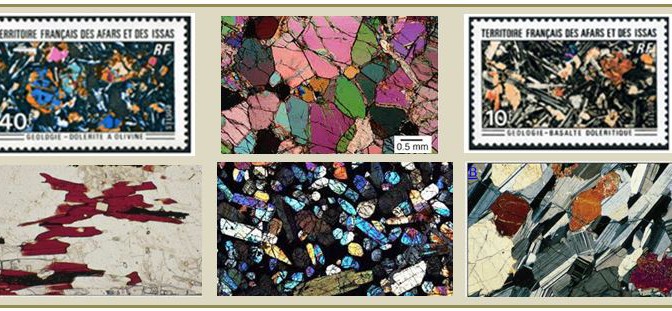People come in all sizes and so do collectible rocks and minerals. There are collectors who prefer garden rocks, as big as they can carry (or even bigger). These people will do this until their yards or patios are completely covered by rocks. And then they start building piles. You know who you are! There are folks who like cabinet specimens of several inches. You need space to display these also and typically quality cabinet specimen can deplete the wallet all too quickly.
Me, I prefer mineral specimens that are called miniatures, no longer than 2” in their longest dimension. A few dozen can fit on a display shelf or in a drawer. Of course there are thumbnail collectors who specialize in specimens that can fit into a one inch cube. They even have neat little special boxes, called Perky boxes named after the collector/dealer that popularized the theme. And then there are the micromounters. These collectors can purchase much of their material less expensively and the number of available minerals seems endless, but then they require binocular microscopes and perhaps close-up camera lens to best view their prized possession.
But what about collecting minerals on thin section. Is there a place for that? OK, first off what is a thin section? According to the bible of the internet, Wikipedia tells us that a thin section is a “laboratory preparation of a rock, mineral, soil, bone, or even metal for use with a polarizing microscope”. Fine, but what is it? Let me try: a thin section is a tiny sliver of rock, typically mounted/glued onto a microscope slide that permits light to pass through all the transparent mineral phases. As it turns out if you mount a polished rock surface onto a glass microscope slide and grind/polish the surface down to 30 microns in thickness (that’s about 1/800th of an inch for the metrically challenged) then many minerals will display characteristic colors and properties upon the transmission of polarized light. In this way minerals can be identified under the microscope. Further-more their textures and how they are intergrown with each other can be used to interpret how the minerals grew and how a rock might have formed.
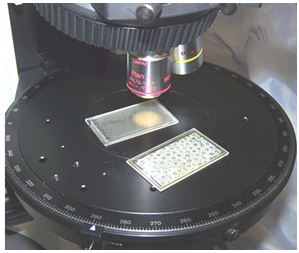
What is polarized light you say? Normal light from the sun or an artificial source travels as a light wave and vibrates in both horizontal and vertical directions. This light is unpolarized. To polarize light it is necessary to remove one of those components such that the light wave is vibrating in a single plane. The best method to do this involves a simple Polaroid filter that blocks one of the planes of the incoming light. The light passing through the filter then strikes the thin section completely polarized. So why do this you might ask? Well, there are many reasons, but let’s address two.
Pleochroism: Many minerals display a property called pleochroism when subjected to a polarized light source. Simply put they absorb and refract the polarized light differently depending on the angle of incidence of the light into the crystal structure. The result is that the color of the light wave that passes through the mineral changes with orientation, and the mineral is said to exhibit pleochroism.
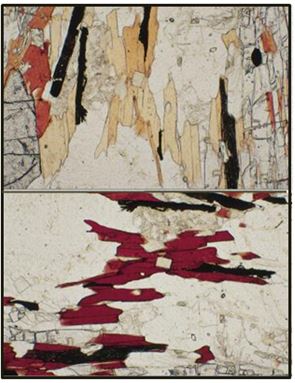
Rotating the thin section on the microscope stage causes these minerals to literally jump out when viewed as they change colors with orientation. This helps to identify and distinguish many minerals. Many minerals show strong pleochrosim: biotite, beryl, many amphiboles, some pyroxenes, titanite, apatite, corundum and tourmaline to name a few.
Birefringence: If one polarizer is good, two must be better! If a polarizer can restrict passing light to one plane, then a second polarizer can be set up to block that direction such that no light will pass. But, if we put our thin section in between the two perpendicular polarizers then any refraction or unalignment of the light caused by the mineral in between will not be blocked. The light that passes through is then solely a function of the capacity of the mineral being observed to refract the polarized light. As with pleochrosim, birefringence depends on crystal orientation and rotation of the thin section is a key process in evaluating birefringence. Calcite is very strongly birefringent, other minerals which display colorful birefringence are tremolite, most micas, epidote, some pyroxenes.
Naturally, observing a lack of pleochrosim or birefringence can be equally diagnostic. Isotropic phases like fluorite, garnet or spinel will lack these properties when viewed in thin section under polarized light. And, of course, truly opaque minerals like magnetite or most sulfides cannot be investigated with transmitted light. They require reflective light microscopy from above. But that is another whole topic.
It is, of course, more complicated than this and a thin section will contain mineral grains at variable orientations which therefore exhibit varying properties, but a trained petrographer (geologist specializing in describing rocks) can combine observations under incident light, unpolarized transmitted light, plane polarized light and doubly polarized light (or crossed nicols) to identify minerals and rock properties.
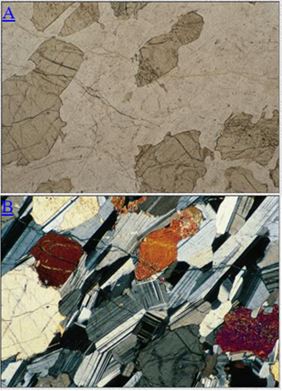
OR perhaps one can just collect thin sections cuz they are pretty in the microscope?
CAVEAT: The problem with collecting thin sections is that the tools of the trade are quite expensive. A decent binocular polarizing microscope is several thousand dollars new, although refurbished scopes are available for just over $1300. Thin section machines can be even more expensive and the process is tedious and a bit of an art. Grind your rocks too far and there will be nothing left. Stop before they get down to 30 microns and the characteristic properties will not be evident. Of course you can send your rocks out for thin sectioning, but that service is not inexpensive either. Expect to pay $20 or more for a standard thin section.
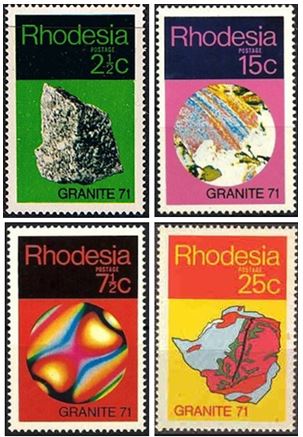
References:
Phillips, W. M., 1971, Mineral Optics, Freeman and Company, 247 p.
Rhodesia Postal Service, 1971, First Day of Issue Information Card for Stamps Honoring Granite Seminar
